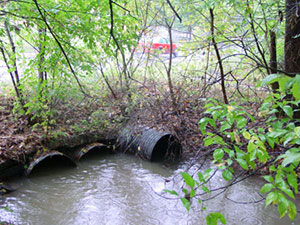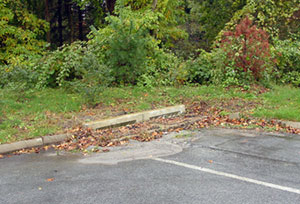National Pollutant Discharge Elimination System (NPDES)
The National Pollutant Discharge Elimination System (NPDES) is a program established by the Federal Clean Water Act and the Pennsylvania Clean Streams Law. It is a permitting system that regulates point sources of water pollution, with the goal of improving water quality.
Both Federal and Pennsylvania laws require wastewater dischargers to receive a permit that establishes their maximum allowable pollution limits, as well as specifies monitoring and reporting requirements for future permitting benchmarks and recordkeeping. The NPDES permit regulates household and industrial wastes that are collected in sewers and treated at municipal wastewater treatment plants. Specifically regulated pollutants include those found in household, commercial and industrial sanitary waste, fecal coliform, oil and grease, toxic pollutants (as listed on the EPA website and other pollutants that according to EPA are "not conventional or toxic that may require regulation," including nutrients like nitrogen and phosphorous.
Pollution also comes from "point" sources, which are discrete conveyances such as pipes or man-made ditches. Individual homes that are connected to a municipal system, use a septic system, or do not have a surface discharge do not need an NPDES permit; however, industrial, municipal, and other facilities must obtain permits if their discharges go directly to surface waters. The permits also regulate industrial point sources and concentrated animal feeding operations (CAFO) that discharge into other wastewater collection systems, or that discharge directly into receiving waterways. Permits regulate these discharges with the goals of protecting public health and aquatic life, and ensuring that every facility treats wastewater. To achieve the goals of the program, permits usually include site-specific discharge limits, as well as compliance monitoring and reporting requirements and enforcement actions if regulated facilities fail to comply with their permits.
Phase I of this program, issued in 1990, required medium and large cities or certain counties with populations of 100,000 or more to obtain NPDES permits for their stormwater discharges. Phase II, issued in 1999, requires regulated small "Municipal Separate Storm Sewer Systems" (MS4s) in urbanized areas, as well as small MS4s outside the urbanized areas that are designated by the permitting authority, to obtain NPDES permit coverage for their stormwater discharges.
The NPDES permit is generally valid for a period of five years. Applications for renewal of NPDES permits must be submitted at least 180 days prior to the expiration of the current facility permit. Applications for NPDES permits can be obtained from DEP regional offices or on the DEP website.
Advantages
 Implementation of NPDES permitting provides the following advantages:
Implementation of NPDES permitting provides the following advantages:
- Improved water quality: Water quality can be improved on a watershed-wide basis;
- Improved biodiversity: Less pollution promotes more plant and aquatic life.
- Assists Farmers: Less pollution in waterways can result in the improvement in herd health for farmers
- Protects key environmental resources.
- Preserves important wildlife and aquatic habitats: Individual species are also preserved.
- Promotes energy conservation: By limiting damage due to erosion and sedimentation, costly mitigation measures are avoided.
Limitations
The following challenges are associated with stormwater management BMPs:
- Cost: There are many wastewater treatment facilities within the County that require attention and the cost to implement the NPDES program can be substantial.
- Cost: Increased paperwork, applications, and engineering costs can result. Working toward meeting water quality standards once a watershed or drainage area has been degraded is costly and regulations can be significant.
- Increased administration and enforcement: There will likely be an increase in inspections and enforcement.
- Increased education requirements: Continued education is required of reviewers, planners, municipal officials and designers to keep up to date with regulations.
How to Address the Implementation of NPDES
 There are a variety of ways to implement the NPDES program at the municipal level. Implementation through public education and outreach, illicit discharge detection and elimination, construction site runoff controls, and post-construction runoff controls can all help municipalities meet the requirements of the NPDES and MS4 programs. Municipal, agricultural, industrial and wastewater treatment plant efforts to design programs and infrastructure systems can ultimately reduce the discharge of pollutants into waterways, and water quality is ultimately improved and meeting the requirements of the Clean Water Act as well as the requirements of the DEP-issued NPDES permits can be achieved.
There are a variety of ways to implement the NPDES program at the municipal level. Implementation through public education and outreach, illicit discharge detection and elimination, construction site runoff controls, and post-construction runoff controls can all help municipalities meet the requirements of the NPDES and MS4 programs. Municipal, agricultural, industrial and wastewater treatment plant efforts to design programs and infrastructure systems can ultimately reduce the discharge of pollutants into waterways, and water quality is ultimately improved and meeting the requirements of the Clean Water Act as well as the requirements of the DEP-issued NPDES permits can be achieved.
Permit holders can coordinate and work with the Conservation District, local watershed associations, the Chester County Water Resources Authority and Planning Commission to help navigate the regulatory framework of DEP and the EPA permitting processes.
Examples
Watersheds 2045 was adopted in 2024 as Chester County's integrated water resources plan, as well as the County-wide Act 167 Stormwater Management Plan and the County-wide Rivers Conservation Plan. It includes the updated 2022 Stormwater Management Model Ordinance, along with a Standards Matrix for stormwater management related to land disturbance, Christina Basin MS4 Total Maximum Daily Load Implementation Strategy, Act 167 Plan consistency requirements for state financed projects, and additional documentation required to fulfill the Act 167 plan requirements.
Related References
- The Chester County Water Resources Authority's mission is to provide, among other things, information and planning that helps sustain the natural quality, quantity and biodiversity of the County's water resources. They have also carried the goals, objectives, and strategies from Watersheds: An Integrated Water Resources Plan for Chester County, into the PA Act 167 Stormwater Management Plan, that is currently in the adoption process. View more information on water quality.
- The Chester County Conservation District helps promote sustainable use of resources through education and technical assistance to farms, landowners, watershed organizations and others.
- The Environmental Protection Agency has an online section dedicated to the NPDES program, current issues, and other related topics. The site contains technical and regulatory information pertaining to the NPDES permit program, as well as programs and initiatives that fall under the purview of the NPDES Program.
- The EPA also has a webpage that includes Frequently Asked Questions for the NPDES program.
- The Pennsylvania Department of Environmental Protection (DEP) provides an online section for the Pennsylvania NPDES Permit Program, including general information, types of regulated pollutants, and links to technical assistance and the electronic links to the NPDES Permit Applications.
- The Pennsylvania Code, Chapter 92a. National Pollutant Discharge Elimination System Permitting, Monitoring, and Compliance.


